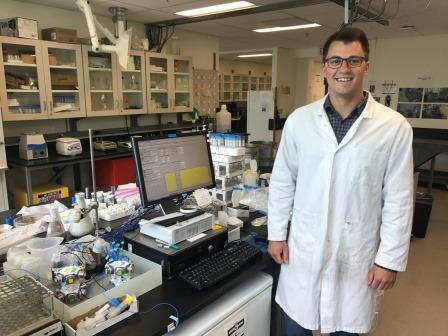Biography:
Sterling grew up on the Sunshine Coast, B.C. and completed his B.Sc. in Geological Sciences at Queen’s University, and then went on to do a Master’s in Environmental Studies at Queen’s University. Sterling began his Ph.D. in Geology at the Mineral Deposit Research Unit of the University of British Columbia in 2016. Since starting at UBC, Sterling has been working with mining companies from B.C. and South Africa to develop and demonstrate new technologies for sequestering CO2 in mine tailings. Upon completing his Ph.D., Sterling aspires to continue to work as a CO2 sequestration consultant for industry and contribute to the full-scale implementation of technologies currently under development
Project: Carbon Mineralization in Ultramafic Tailings: A Prospect for Stabilizing Mine Waste and Reducing Greenhouse Gas Emissions
Sterling’s research focus is on developing technologies to make B.C. home to the first greenhouse gas neutral nickel mine while providing the co-benefits of stabilizing the mine’s tailings and potentially reducing the capital costs associated with the project’s development. This can be achieved through carbon mineralization, where carbon dioxide gas (sourced from the atmosphere or flue gases) is effectively turned into stone by promoting the formation of secondary magnesium carbonate minerals that act as a cement that stabilizes the tailings. In order to investigate this process and develop new low-cost methods to accelerate the reactions, Sterling conducts experimental studies that are paired with geochemical and geometallurgical models.
This approach allows to determine what step in the reaction series is currently causing the “bottle neck” that controls the overall rate at which carbon dioxide can be sequestered, and from this they can “fine tune” the process to achieve better results. Furthermore, the geometallurgical models helps to identify zones of the nickel deposit that will produce tailings that contain minerals that are naturally very reactive with carbon dioxide so that we do not need to employ expensive technologies that utilize high temperatures, high pressures, and/or chemicals to make less reactive minerals sequester carbon dioxide. In addition to reducing the economic costs and environmental risks associated with storing nickel tailings, this approach could further improve the project’s economics by reducing carbon taxes. Ultimately, nickel mining could remove more carbon dioxide from the atmosphere than it produces, and may provide an additional revenue stream through carbon trading.
